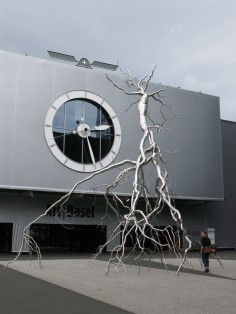ROXY PAINE
روكسي باين
רוקסי פיין
ロキシー·パイネ
록시 페인
inversion
source: blogsartinfo
Roxy Paine’s stainless-steel tree sculptures have captured the public’s imagination, and mine as well. I’ve seen some of them installed in parks in New York, Seattle, Saint Louis, Washington, DC, and elsewhere, and they always demand and reward my attention. For one thing, they are beautiful, and for another, they make me think – two essential attributes as far as I am concerned. (Yes, I know, some great art is not conventionally beautiful, but that’s another discussion.)
Roxy Paine’s stainless steel Inversion was shown at Art Basel in 2008, and is bound for the Israel Museum in Jerusalem.
Paine calls the series “Dendroids,” a name that combines dendron, Greek for “tree”, and “oid,” a suffix meaning “form.” But the title is more nuanced. Other words derived from dendron refer to branching systems, and in zoology “oid” denotes a creature belonging to a higher level of taxonomy. So “Dendroids” aren’t just tree forms, but allusions to branching structures from neurons to rivers to genealogical charts. And a viewer may be moved to consider the congruencies among such disparate but related systems.
Their translation of organic forms into cold, hard steel reminds me about the intersection of nature and human industry. This is a terrain that Paine inhabits. He is known also for hyper-real replications of plants and fungi using polymer and other materials.
Just what is a “Dendroid”?
The “Dendroids” — always leafless — point to a future about which we remain profoundly uneasy – a time when we routinely will substitute the manmade for the natural. This is where the “oid” comes in: today the suffix suggests a manufactured substitute, the prime example being “android,” a counterfeit man (andros). The beginnings are already here in the form of bioengineered livestock and vegetables and lab-grown organs. Despite its promise the whole business is somehow disturbing, and Paine’s work is all the more unsettling for its spectacular and beguiling beauty.
Metal trees are not new. I remember encountering some 18th-century examples in the garden of the tsarist Peterhof Palace outside of St Petersburg, Russia. They were humorous diversions that surprised strollers by suddenly creating a downpour. And Paine is not the only contemporary artist I admire who makes metal tree sculptures. Some of Rona Pondick’s sprout human heads and the ground beneath others is littered with apple-like fruits that contain toothy mouths. Their nightmarish surrealism represents psychological pain with Old Testament overtones about human nature.
.
.
.
.
.
.
.
.
source: blogchinaalibaba
美国现代艺术家洛克西·潘(Roxy Paine)的树形系列雕塑是其招牌性作品。
通过一系列不锈钢大树,作者表现了现代都市生活中,人与人、人与自然、虚拟与现实等形成的剪不断理还乱的网络关系。这些大树都是由不锈钢焊接而成,体积大、银色外观与现代都市建筑呈现出微妙的和谐,而形态又和自然界的树木相同,极具视觉冲击力,人们在驻足观赏的同时也会不禁思考
.
.
.
.
.
.
.
source: lallavedelestudioblogspot
Las primeras obras de Roxy Paine que me llamaron la atención fueron un grupo de masas, con aspecto viscoso y colores brillantes. Pensé que guardaban cierta relación con mis “Fluidos”. Al continuar conociendo la obra de esta artista, encontré esta serie de árboles de acero inoxidable.
Son muchos los artistas que han trabajado o trabajan en la actualidad con los árboles, pero creo que los de esta artista merecen ser destacados.


